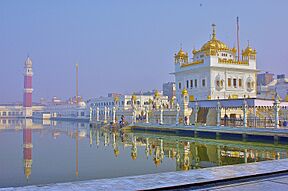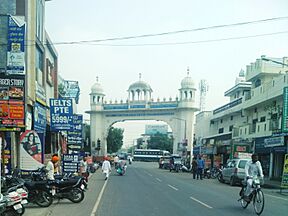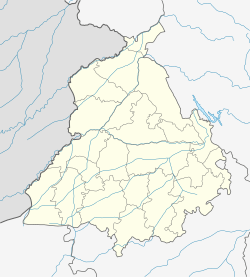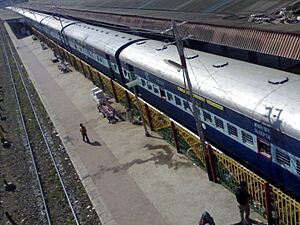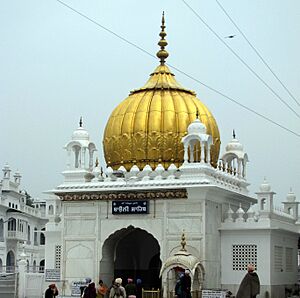Tarn Taran Sahib facts for kids
Quick facts for kids
Tarn Taran Sahib
|
|
|---|---|
|
City
|
|
|
clockwise from top:
Gurdwara Tarn Taran Sahib, Sri Guru Arjan Dev Ji Gate. |
|
| Country | |
| State | Punjab |
| District | Tarn Taran |
| Founded by | Guru Arjan Dev Ji |
| Area | |
| • Total | 70 km2 (30 sq mi) |
| Elevation | 500.5 m (1,642.1 ft) |
| Population
(2011)
|
|
| • Total | 66,847 |
| • Rank | 3th In Punjab |
| Demonym(s) | Tarn Tarn Sahib Wale |
| Languages | |
| • Official | Punjabi |
| Time zone | UTC+5:30 (IST) |
| PIN |
143401
|
| Telephone code | +91 (225) 1852 |
| Vehicle registration | PB-46 |
| Sex ratio | 764 ♂/♀ |
Tarn Taran Sahib is a city in the Punjab state of northern India. It is the main city of the Tarn Taran district. A very important Sikh temple, Gurdwara Sri Tarn Taran Sahib, is right in the middle of the city.
Contents
History of Tarn Taran Sahib
Tarn Taran Sahib was founded around 1500 CE by the Fifth Sikh Guru, Guru Arjan Dev Ji (1563–1606). He loved the natural beauty of the area. He named the town Tarn Taran, which means "pool of salvation" in English. Guru Arjan Dev Ji also started building the Sri Tarn Taran Sahib Temple.
From 1716 to 1810, a powerful Jatt family from the Dhillon clan ruled Tarn Taran Sahib. This was part of the Bhangi Sikh Dynasty. In 1947, when India was divided, Tarn Taran was one of the few areas in Punjab with mostly Sikh people. The city was a center for Sikh activities in the 1980s and early 1990s. Most people in this area work in farming and related industries.
The Tarn Taran district was created in 2006. The Chief Minister of Punjab, Captain Amarinder Singh, announced this. It became the 19th district of Punjab.
Ranjit Singh's Contributions

Maharaja Ranjit Singh helped finish the holy tank (sarovar) at Tarn Taran. He completed the steps and paved the path around it. The Darbar Sahib temple was also rebuilt. Maharaja Ranjit Singh and his grandson, Kanvar Nau Nihal Singh, gave a lot of gold for the temple's outer walls. However, the work slowed down after Ranjit Singh's death.
Later, in the late 1800s, Sant Sham Singh from Amritsar helped cover part of the temple with gold leaf. Kanvar Nau Nihal Singh had planned four towers around the tank, but only one was built at that time. Maharaja Ranjit Singh also ordered a wall to be built around the town of Tarn Taran. Other important shrines, like the Mahji Sahib and Akal Bunga, were also developed.
Tarn Taran Under British Rule
After the British took over Punjab, they appointed a manager for the shrines in Tarn Taran and Amritsar. This manager oversaw things, but the priests handled religious matters. The priests kept the offerings and land meant for the Darbar Sahib. They often neglected their duties and the holy places.
The Singh Sabha, a reform movement, started in Tarn Taran in 1885. They wanted to fix the problems and corruption. The British-appointed managers and priests resisted these changes. However, other Sikh groups also worked to clean up the administration.
Gurdwara Reform Movement
The Gurdwara reform movement helped Sikhs take control of their holy shrines. On January 27, 1921, the Shiromani Gurdwara Parbandhak Committee became responsible for managing the gurdwaras.
Guru Arjan Dev had started a place for people with leprosy, believing the water had healing properties. After Sikh rule ended, Christian missionaries took over this asylum in 1858.
People and Population
As of 2011[update] According to the 2011 Indian census, Tarn Taran Sahib had a population of 66,847 people. About 52.3% of the population were males, and 47.7% were females. The city's average literacy rate was 79.33%, which is higher than Punjab's state average. About 11.2% of the population was under 6 years old.
Religions in Tarn Taran
Religion in Tarn Taran (2011) Sikhism (75.7%) Hinduism (23.2%) Christianity (0.7%) Islam (0.3%) Others (0.1%)
Most people in Tarn Taran are Sikhs. The table below shows the different religious groups in the city based on the 2011 census. It also shows the gender ratio for each group.
| Religion | Total | Female | Male | Gender ratio |
|---|---|---|---|---|
| Sikh | 75,584 | 31,232 | 33,352 | 919 |
| Hindu | 15,499 | 7,305 | 8,194 | 891 |
| Christian | 488 | 230 | 258 | 891 |
| Muslim | 202 | 92 | 110 | 836 |
| Buddhist | 16 | 8 | 8 | 1000 |
| Jain | 10 | 5 | 5 | 1000 |
| Other religions | 7 | 2 | 5 | 400 |
| Not stated | 41 | 22 | 19 | 1157 |
| Total | 91,847 | 31,896 | 34,951 | 912 |
Culture and Holy Places
Hub of Sikh Culture
Tarn Taran city has many historical gurdwaras, which are Sikh temples. These include:
- Darbar Sahib Sri Guru Arjan Dev Ji
- Gurdwara Guru Ka Khuh (Gurdwara of the Guru's Well)
- Gurdwara Bibi Bhani Da Khuh
- Gurdwara Takkar Sahib
- Gurdwara Lakeer Sahib
- Gurudwara Baba Garja Singh Baba Bota Singh
- Gurdwara Jhulna Mahal
- Lalpur (Tapeana Sahib)
The main religious center in Tarn Taran Sahib is Sri Darbar Sahib Tarn Taran. It was built by Sri Guru Arjan Dev Ji. The Gurdwara Sri Darbar Sahib Tarn Taran has one of the largest sarovar (holy tank or pond).
Gurdwara Darbar Sahib
This gurdwara is a beautiful three-story building. It is located at the southeastern corner of the sarovar. You enter through a large arched gateway. The building stands on a platform made of marble. The top part of the temple is covered with shiny gold-plated sheets. The lotus-shaped dome was damaged in an earthquake in 1905 but was rebuilt. It has a golden top with an umbrella shape. The inside walls and ceiling are decorated with amazing stucco work and reflecting glass pieces. The Guru Granth Sahib (Sikh holy scripture) sits on a platform under a golden dome. This golden throne was a gift from Kanvar Nau Nihal Singh. Hymns (Kirtan) are sung here from early morning until late evening.
Har Ki Pauri
These are marble steps behind the Darbar Sahib that go down into the holy pool. It is believed that Guru Arjan Dev Ji made the first cut here when digging started in 1590. Pilgrims go down these steps to take sips of the holy water.
The Sarovar (Holy Tank)
This is one of the largest Sikh holy tanks. It is shaped like a rectangle. Its sides are about 289 meters (948 feet) and 283 meters (928 feet) long. The eastern and western sides are about 230 meters (755 feet) and 233 meters (764 feet) long. The sarovar was first filled by rainwater. In 1833, Maharaja Raghubir Singh had a channel dug to connect the tank to a canal. This channel was later cemented and covered.
The tank has been completely cleaned twice by volunteers (karseva). Many of the old buildings around the sarovar have been removed. A covered walkway has been built around the edge instead. The name Tarn Taran originally belonged to this sarovar. It means "the boat that takes one across (the ocean of life)." Sikh tradition says the water of the old pond had healing powers, especially for leprosy. Because of this, the sarovar was also known as Dukh Nivaran, meaning "the remover of suffering."
Akal Bunga
This is a four-story building near the Nishan Sahib (Sikh flagpole). It was built in 1841 by Kanvar Nau Nihal Singh. Maharaja Sher Singh added the final touches. The Guru Granth Sahib is brought here for the night after a procession around the sarovar.
Manji Sahib
This is a small shrine in the eastern part of the path around the sarovar. It marks the spot where Guru Arjan Dev Ji watched the digging of the sarovar. A large hall has now been built near it.
The Tower
Only one of the four towers planned by Kanvar Nau Nihal Singh was completed. It stands at the northeastern corner of the sarovar. This three-story tower is 34 meters (112 feet) high. The dome on top was added later.
Gurdwara Lakeer Sahib
This gurdwara is where Baba Deep Singh Ji drew a line on the ground. He did this before going into battle against the Mughal Empire in 1757.
Gurudwara Bibi Bhani da Khuh
This gurdwara is near Sri Darbar Sahib Tarn Taran. It is named after Bibi Bhani Ji. She was the daughter of Guru Amar Das, wife of Guru Ram Das, and mother of Guru Arjan Dev Ji. Guru Arjan Dev Ji dug this historic well (khuh) to remember his mother. She used to serve food, water, and medicine to people in need here. Locals helped build a gurdwara at this spot.
Gurdwara Guru Ka Khuh
This gurdwara is also in Tarn Taran City. This well belonged to Guru Arjan Dev Ji, and a historic gurdwara has been built here.
Other gurdwaras in the Tarn Taran District include:
- Gurdwara Baoli Sahib in Goindwal Sahib
- Gurdwaras in Khadoor Sahib
- Gurdwaras in Baba Buddha Sahib (Bir Sāhib)
- Some gurdwaras in Amritsar
Goindwal Sahib
Goindwal Sahib is located along the River Beas, about 23 kilometers (14 miles) from Tarn Taran Sahib. It is an important place for Sikhism because Guru Arjan Dev Ji was born there.
Economy and Industries
Tarn Taran has many industries, from small to large:
- Rana Sugar Distilleries (in Village Lokha)
- Cooperative sugar mill (in Village Sheron)
- World Famous Fish Market (in Village Harike)
- Asia's Largest Poultry Farm (in Village Gagobuha)
- Ambition Poultry Farm (in Village Rure Asal)
- Tarn Taran Grain Market (one of India's biggest grain markets)
- Tarn Taran district has about 58 Rice Shellers
- Goindwal Sahib Power Plant (a 540 MW power plant by GVK Industries)
- Spinning Mills in Goindwal Sahib
- Thread Mills in Goindwal Sahib
- Lt Foods Ltd
The government also plans to set up a special economic zone (SEZ) at Sri Goindwal Sahib.
Education in Tarn Taran
Here are some colleges in Tarn Taran Sahib city:
- Government Polytechnic College
- Sri Guru Teg Bahadur State University of Law
- International College of Nursing (ICN)
- Guru Gobind Singh Khalsa College
- Guru Gobind Singh Khalsa College for Women
- Punjab College of Law
- Sewa Devi College
- Mata Ganga College for women
- Majha College for women
- Kalian Homeopathic College
- Mai Bhago Institute of Nursing
- Shiv Shankar Institute of Engg and Tech (Patti)
- Shaheed Bhagat Singh Pharmacy (Patti)
- Shaheed Bhagat Singh Polytechnic College
- Shaheed Bhagat Singh B.Ed College
- Goutam college Tarn Taran
- Guru Gobind Singh Khalsa College Sarhali
Here are some schools in Tarn Taran Sahib:
- Maharaja Ranjit Singh Public School
- Sri Guru Harkrishan Public School
- St. Francis Convent School
- Mamta Niketan Convent School
- St. Thomas Convent School
- Guru Arjun Dev Khalsa School
- Punjab Children Academy
- Cupid's School
- Mata Ganga Girls School
- SD Sen Sec Public School
- Sant Singh Sukha Singh Public School
- SSS Public School
- Arya Girls School
- Govt. Sen Sec School
- Guru Nanak Dev Academy
- Majha Public School
- SD Girls High School
- Universal Academy
- SBDS Sen Sec School Patti
- Shri Mahavir Jain Model High School Patti
- S.B.B.S Sen Sec School Rasulpur
- Baba Deep Singh Public School
- Guru Amar Dass Adarsh Institute Goindwal sahib
- Guru Amar Dass senior secondary school Goindwal sahib
Travel and Transport
Air Travel
The closest airport is Amritsar International Airport. It is about 30 kilometers (19 miles) away. You can find direct international flights to cities like London, Dubai, and Singapore. Domestic flights connect to almost every major city in India.
Rail Travel
Tarn Taran is well-connected by train to nearby cities and villages. The Tarn Taran station is on the Amritsar-to-Khemkaran line. A new rail line from Tarn Taran Sahib to Goindwal Sahib has been built. Another project for a rail line from Patti to Ferozpur is currently under construction.
Road Travel
Tarn Taran is connected by roads to many other places, including:
- Amritsar, Pathankot, Jammu
- Patti, Khemkaran
- Kapurthala, Jalandhar
- Jandiala Guru, Beas
- Bathinda, Bikaner
- Chabhal, Attari/Wagha
- Khadur Sahib, Goindwal Sahib
- Mohanpura
- Shahbajpur, Punjab
Tarn Taran is located on the historic Royal Highway (Sher Shah Suri Marg). This road was used by the Mughal Empire from Delhi to Lahore. National Highway No. 15 (NH-15) also passes through Tarn Taran. The city has a fast bus service to Amritsar, with about 450 buses running daily. Many bus companies, like PUNBUS and PRTC, have routes to Tarn Taran. Daily bus services run to and from major cities like New Delhi, Chandigarh, and Ludhiana. There is also a weekly bus service to Ponta Sahib.
Tourism and Attractions
Places to visit in and around Tarn Taran Sahib include:
- Gurdwara Beed Baba Budda Sahib, on the Chaabal - Amritsar road
- Gurdwara Goindwal Sahib
- Gurdwara Khadur Sahib in Khadoor Sahib city
- Harike Wetland, a home for many plants and animals
- Gurdwara Dukh Niwarn Sahib, in Village Thathi-Khara
- Haveli at Jandiala
Notable People from Tarn Taran
- Baba Deep Singhji, a Sikh martyr
- Baba Gurdit Singh, connected to the SS Komagata Maru incident
- Bhai Bidhi Chand Chhina, a Warrior
- Bhai Maha Singh, a Sikh martyr
- Dara Singh, a famous wrestler
- Gurdial Singh Dhillon, former speaker of Lok Sabha in India
- Gurpreet Singh (shooter), won two medals in the Commonwealth Games
- M. S. Gill, former Chief Election Commissioner and Sports Minister of India
- Mai Bhago, a Sikh martyr
- Pratap Singh Kairon, former Chief Minister of Punjab
- Krishan Kant, former Vice-President of India
- Surender Mohan Pathak, a Novelist
- Teja Singh Samundri, founder of SGPC
- Baba Baghel Singh, who once occupied Delhi
- Baba Sohan Singh Bhakna, Founder and President of the Gadar party
- Gurbaksh Chahal, an entrepreneur and writer
- Prem Dhillon, Punjabi Singer
- Jordan Sandhu, Punjabi Singer
- Paintal, Indian actor
See also
 In Spanish: Tarn Taran para niños
In Spanish: Tarn Taran para niños


